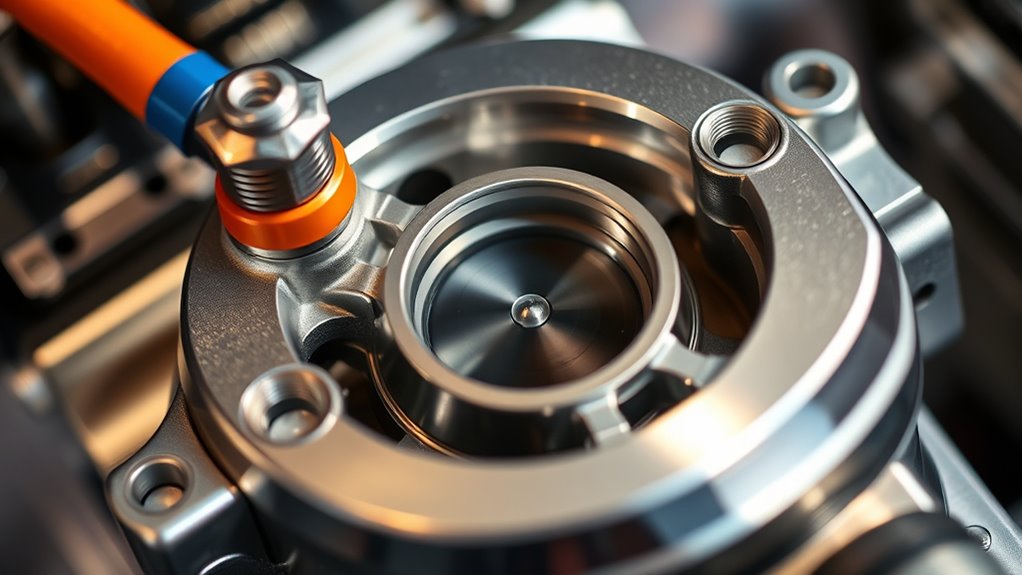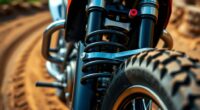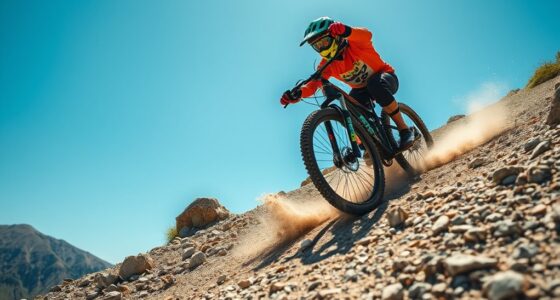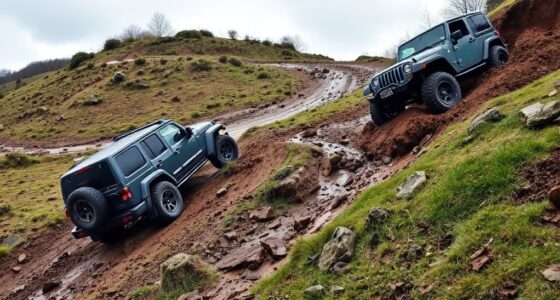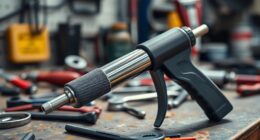To maximize top speed on your two-stroke, fine-tune your carburetor by adjusting the main jet for higher RPM fuel flow and raising the needle for better mid-range response. Start with manufacturer specs, then make small, incremental changes while testing on flat, straight terrain. Confirm your carb is clean and components are in good shape. For detailed steps to perfect your setup and avoid common mistakes, keep exploring the core principles behind jetting.
Key Takeaways
- Start with manufacturer-recommended jet sizes and make small incremental adjustments for optimal top speed.
- Increase the main jet size gradually to enrich the high-RPM fuel mixture without causing excessive smoke.
- Raise the needle position for a leaner mid-range mixture to improve throttle response and top-end power.
- Ensure proper airflow by using a high-flow air filter and exhaust modifications to maximize engine breathing.
- Systematically test and record each adjustment, riding on flat terrain at full throttle for accurate tuning.
Understanding the Role of the Carburetor and Jets
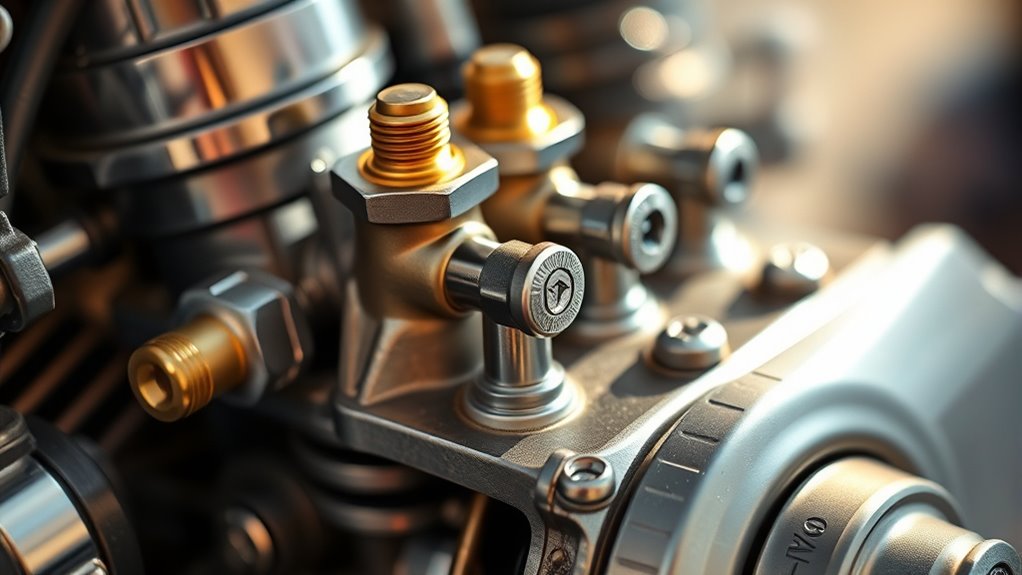
The carburetor plays a crucial role in mixing air and fuel for your engine, guaranteeing it runs smoothly and efficiently. It controls how much air enters and how much fuel is delivered, which directly affects engine performance. Jets are small components within the carburetor that regulate fuel flow, adjusting the mixture for different operating conditions. The size and type of jets determine how rich or lean the fuel mixture becomes. Proper jetting ensures your engine gets the right air-fuel ratio, optimizing power and responsiveness. If the mixture is too rich, you’ll experience sluggishness and fouled spark plugs. Too lean, and you risk engine overheating or knocking. Understanding how the carburetor and jets work together helps you fine-tune your bike for maximum top speed and smooth operation. Regular inspection and maintenance of the vetted survival gear can also ensure your motorcycle remains reliable in demanding conditions.
Identifying the Right Jetting Components for Your Two-Stroke

To get your two-stroke running its best, you need to choose the right main jet, pilot jet, and needle position. Each component affects how your engine responds and performs under different conditions. Understanding how to select and adjust these parts helps you tune your carburetor precisely. Paying attention to carburetor components and their interaction is essential for optimal performance.
Main Jet Selection
Choosing the right main jet is essential for optimizing your two-stroke engine’s performance. The main jet controls the fuel flow at high RPMs, directly affecting power and top speed. If the jet is too small, your engine runs lean, causing hesitation and potential damage. Too large, and it runs rich, reducing power and increasing fuel consumption. To select the correct size, start with a baseline recommended by your engine or carburetor manufacturer. Then, perform a series of tests, gradually changing the jet size in small increments. Pay attention to throttle response, engine sound, and top speed. Once you notice a smooth, responsive throttle with maximum power, you’ve found the right main jet. Proper jetting ensures your two-stroke reaches its maximum potential without risking engine damage. Additionally, understanding carburetor jetting and tuning your components accordingly can significantly improve your engine’s overall performance.
Pilot Jet Tuning
Ever wondered how to fine-tune your engine’s response at low throttle settings? The pilot jet plays a key role here. It controls the fuel flow during idle and light throttle, affecting smoothness and responsiveness. To identify the right jet, start by noting your current jet size and how the engine behaves at low RPMs. If it stalls or runs rough, consider a smaller jet for leaner fuel mixture; if it’s sluggish or bogs, a larger jet might help. Always check for signs like hesitation or inconsistent idling. Remember, changing the pilot jet isn’t just about size—it’s about matching your engine’s specific needs. Make small adjustments and test ride after each change. Proper pilot jet tuning ensures your two-stroke runs smoothly from idle to initial acceleration. Additionally, understanding your color accuracy can help in diagnosing visual inconsistencies during testing.
Needle Position Adjustment
Have you ever considered how needle position impacts your two-stroke’s performance? Adjusting the needle height changes how much fuel mixes with air, directly affecting throttle response and power delivery. If you’re running lean or experiencing hesitation, raising the needle can enrich the mixture, boosting power at mid-range. Conversely, lowering it can lean out the mixture if you’re running too rich. To adjust, remove the carburetor cap and slide, then move the needle clip to a different notch. Keep in mind, small changes can make a big difference. Test your bike after each adjustment to find the most effective position for maximum top speed. Proper needle tuning ensures your engine runs smoothly, efficiently, and at peak performance. Catering and Delivery can also benefit from precise adjustments to optimize efficiency and customer satisfaction.
Signs That Indicate Your Current Jetting Needs Adjustment
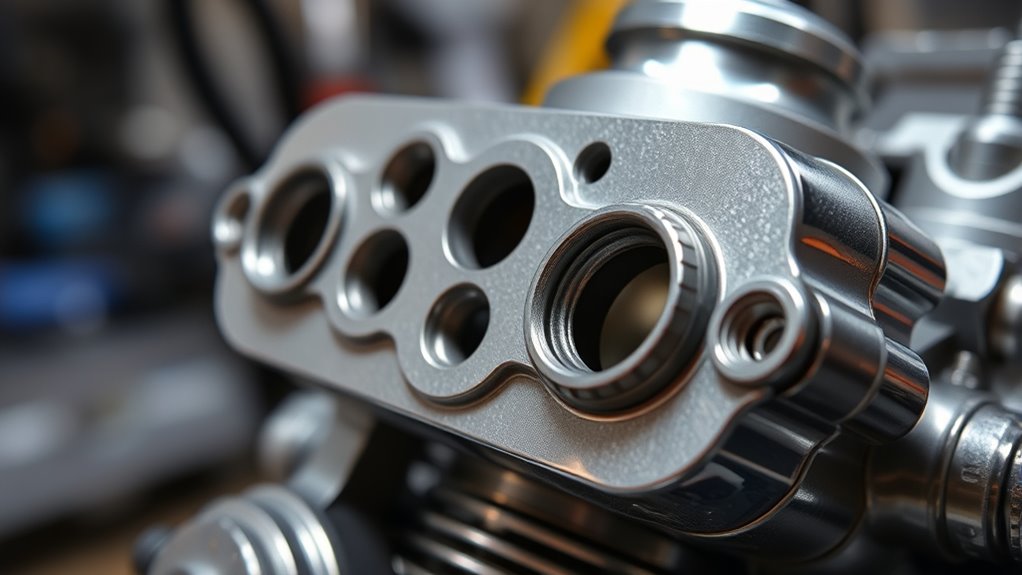
If your engine responds sluggishly or feels unresponsive, your jetting might be off. You could also notice excessive smoke billowing from the exhaust, which signals a problem. Recognizing these signs helps you know when to adjust your carburetor for better performance. Additionally, incorrect jetting may lead to trust erosion, especially if it results in ongoing performance issues that frustrate the rider.
Poor Acceleration Response
Noticing sluggish or inconsistent acceleration is a clear sign your carburetor jetting might need adjustment. If your bike feels slow to respond when you twist the throttle or struggles to reach higher RPMs smoothly, it’s time to check your jetting. Poor acceleration can result from the mixture being too rich or too lean, disrupting ideal airflow and fuel delivery. You may also experience hesitation or bogging during acceleration. These issues often point to incorrect jet sizes that aren’t suited to your riding conditions or modifications. To identify if jetting is the culprit, look for these signs:
- Delayed throttle response
- Hesitation or bogging when accelerating
- Loss of power at mid-range RPMs
- Essential oils for toothache relief can sometimes help ease the discomfort associated with jetting issues by reducing stress and tension during troubleshooting.
Excessive Engine Smoke
Excessive engine smoke is a clear indicator that your carburetor jetting may be off. If your two-stroke starts producing a thick, bluish or grayish smoke, it’s a sign that too much oil or fuel is entering the combustion chamber. This often occurs when the jetting is too rich, meaning the needle or main jet needs adjustment. When you see this smoke, check your jet sizes and mixture settings. Running rich not only wastes fuel but also causes carbon buildup and engine fouling over time. To fix this, lean out the mixture gradually by selecting smaller jets or adjusting the needle. Proper jetting ensures clean combustion, reduces smoke, and maximizes your engine’s performance and longevity. Inadequate maintenance can also contribute to improper jetting and engine issues.
Step-by-Step Process for Proper Jetting Calibration
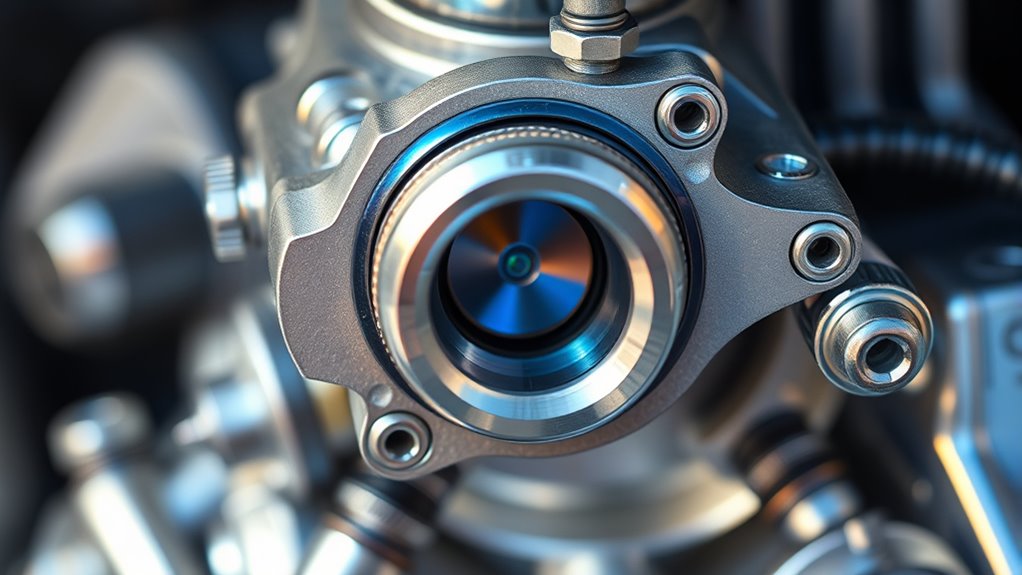
Proper jetting calibration is essential for ensuring your carburetor delivers ideal performance. To get it right, follow a clear step-by-step process. First, start with the manufacturer’s recommended jet sizes as your baseline. Next, adjust the main jet to fine-tune top-end power by swapping jets and testing top speed. Then, modify the needle position for mid-range throttle response. Finally, set the idle mixture to ensure smooth idling and responsiveness. Always test after each adjustment to monitor changes and avoid over-leaning or over-rich conditions. Keep detailed notes of your adjustments for future reference. Remember, proper calibration balances power, efficiency, and engine health. Use these steps as your guide to achieve maximum top speed without sacrificing reliability. Proper priming and cleaning of the carburetor and jets also ensure consistent performance.
Tuning Tips for Achieving Peak Speed Performance
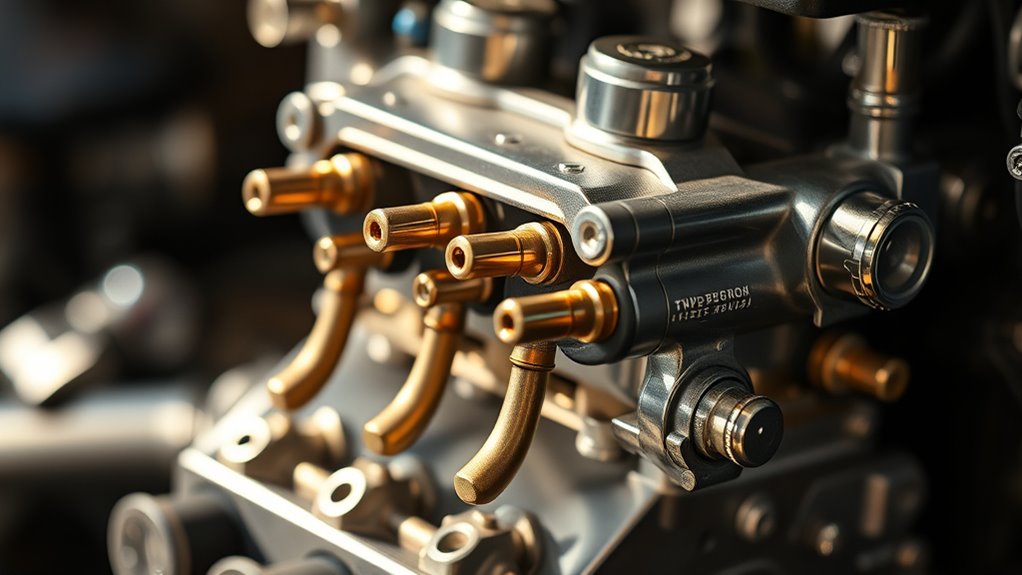
Once you’ve calibrated your carburetor for ideal performance, the next step is to focus on tuning for peak speed. To maximize top-end power, fine-tune your jetting, needle position, and air filter. Keep these tips in mind:
| Adjustment | Effect | Tip |
|---|---|---|
| Main jet size | Increases fuel flow for top speed | Use a slightly larger jet, but avoid bogging down at acceleration |
| Needle position | Alters mid-range fuel mixture | Raise needle for leaner mix at high RPM |
| Air filter | Affects airflow and mixture | Use a high-flow filter for more air intake |
| Exhaust modifications | Can improve flow and power | Consider exhaust port tuning for extra speed |
Implement these tips carefully, test after each change, and remember to stay within safe engine limits.
Common Mistakes to Avoid During Jetting

While fine-tuning your carburetor can boost performance, many riders make common mistakes that hinder ideal jetting. One mistake is ignoring proper baseline settings, which can lead to over- or under-fueling. Another is changing only one jet component at a time without understanding its effect, causing inconsistent results. Additionally, rushing the process and skipping proper testing can leave you with subpar top speed and engine issues. To avoid these errors, guarantee you start with a solid baseline, understand how each jet affects performance, and take your time during adjustments. Patience and systematic testing are key to effective jetting. Remember, small changes can make a big difference, so avoid making abrupt or random modifications. Proper jetting setup is essential for maximum top speed. For enthusiasts interested in overall vehicle enhancement, exploring Honda Tuning options can provide valuable insights into optimizing your motorcycle’s performance.
Testing and Fine-Tuning for Optimal Results
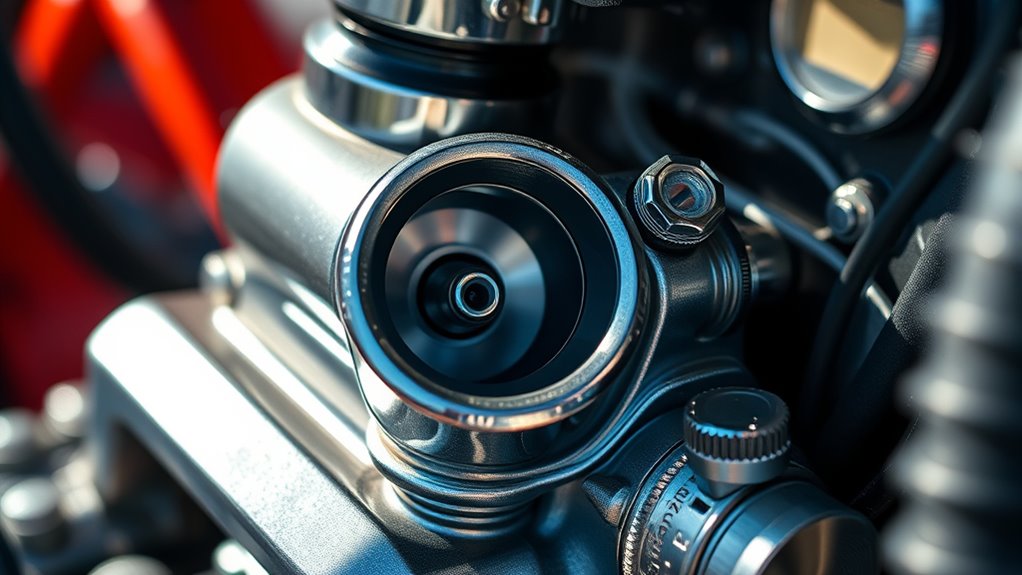
To achieve the best jetting results, systematic testing and fine-tuning are essential. Begin by making small adjustments to your main jet, then test your bike under controlled conditions. Ride at full throttle on a straight, flat stretch, and listen for smooth acceleration and steady RPMs. If the engine bogs or sputters, lean the mixture by decreasing jet size; if it stalls or runs rough, go richer with a larger jet. Record each change and its effect to identify the optimal setup. Repeat this process, gradually refining your jetting until you find the perfect balance for maximum top speed. Patience and precision are key, as small tweaks can significantly improve performance and ensure your two-stroke runs at its peak.
Frequently Asked Questions
How Often Should I Check and Adjust My Jetting?
You should check and adjust your jetting whenever you notice performance issues like hesitation, bogging, or loss of power, especially after riding in different conditions or with modifications. Regularly inspect your carburetor if you ride frequently, ideally every few rides or after every major change in altitude or fuel type. Staying attentive guarantees your engine runs smoothly and maximizes top speed without risking damage or inefficiency.
Can Jetting Affect Fuel Efficiency Besides Top Speed?
Jetting definitely impacts your fuel efficiency. When your carburetor isn’t properly tuned, your engine may run too rich or too lean, causing it to use more fuel than necessary or struggle to perform smoothly. Proper jetting guarantees ideal air-fuel mixture, which not only boosts top speed but also helps you save fuel. Regularly checking and adjusting your jetting keeps your engine running efficiently, saving you money and reducing emissions.
Are There Specific Brands of Jets Recommended for Top Speed?
Imagine you’re in a vintage garage, searching for the best jets. When aiming for top speed, certain brands like Keihin and Mikuni are trusted for their quality and consistency. You should focus on high-quality, precisely manufactured jets, as they guarantee ideal airflow and fuel delivery. While brand matters, proper sizing and tuning are essential. Remember, an old-school approach combined with modern expertise can give you the edge you’re looking for.
How Does Altitude Impact Carburetor Jetting Adjustments?
Altitude affects carburetor jetting because higher elevations have less oxygen, which can cause your engine to run lean if you don’t adjust. You’ll need to change the main jet to a larger size to compensate for the thinner air, ensuring proper fuel mixture. Pay attention to how your engine responds—if it sputters or loses power, make jetting adjustments accordingly to maintain top speed and performance.
What Tools Are Essential for Precise Jetting Tuning?
Imagine holding a set of tiny, precise tools in your hand, each one like a key to unlock peak performance. You’ll need a good set of screwdrivers, a jet gauge, and a carburetor cleaning kit for accurate tuning. A magnifying glass helps see small parts clearly. These tools let you fine-tune your jetting, ensuring your two-stroke engine runs smoothly and hits top speed without guesswork.
Conclusion
Mastering your carburetor jetting is like tuning a finely crafted instrument—every adjustment shapes your two-stroke’s ultimate symphony of speed. When you fine-tune with patience and precision, you reveal the engine’s true potential, letting performance soar like a soaring eagle against the open sky. Remember, the journey to maximum top speed is a delicate dance of balance and trust in your skills—a proof of your dedication and the machine’s silent promise of power.
